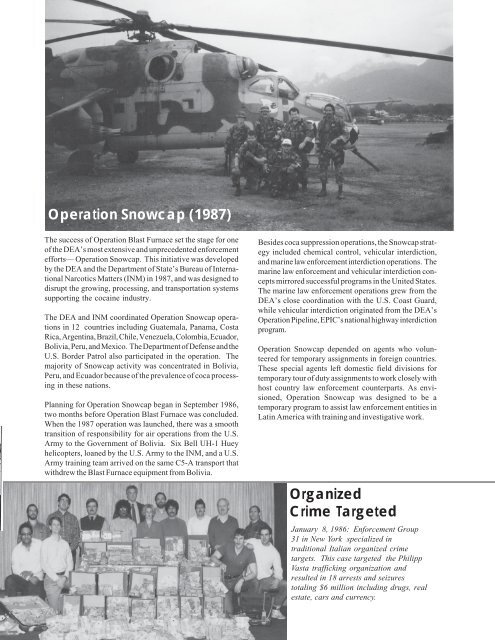Download This File - The Free Information Society
Download This File - The Free Information Society
Download This File - The Free Information Society
Create successful ePaper yourself
Turn your PDF publications into a flip-book with our unique Google optimized e-Paper software.
Operation Snowcap (1987)<br />
<strong>The</strong> success of Operation Blast Furnace set the stage for one<br />
of the DEA’s most extensive and unprecedented enforcement<br />
efforts— Operation Snowcap. <strong>This</strong> initiative was developed<br />
by the DEA and the Department of State’s Bureau of International<br />
Narcotics Matters (INM) in 1987, and was designed to<br />
disrupt the growing, processing, and transportation systems<br />
supporting the cocaine industry.<br />
<strong>The</strong> DEA and INM coordinated Operation Snowcap operations<br />
in 12 countries including Guatemala, Panama, Costa<br />
Rica, Argentina, Brazil, Chile, Venezuela, Colombia, Ecuador,<br />
Bolivia, Peru, and Mexico. <strong>The</strong> Department of Defense and the<br />
U.S. Border Patrol also participated in the operation. <strong>The</strong><br />
majority of Snowcap activity was concentrated in Bolivia,<br />
Peru, and Ecuador because of the prevalence of coca processing<br />
in these nations.<br />
Planning for Operation Snowcap began in September 1986,<br />
two months before Operation Blast Furnace was concluded.<br />
When the 1987 operation was launched, there was a smooth<br />
transition of responsibility for air operations from the U.S.<br />
Army to the Government of Bolivia. Six Bell UH-1 Huey<br />
helicopters, loaned by the U.S. Army to the INM, and a U.S.<br />
Army training team arrived on the same C5-A transport that<br />
withdrew the Blast Furnace equipment from Bolivia.<br />
69<br />
Besides coca suppression operations, the Snowcap strategy<br />
included chemical control, vehicular interdiction,<br />
and marine law enforcement interdiction operations. <strong>The</strong><br />
marine law enforcement and vehicular interdiction concepts<br />
mirrored successful programs in the United States.<br />
<strong>The</strong> marine law enforcement operations grew from the<br />
DEA’s close coordination with the U.S. Coast Guard,<br />
while vehicular interdiction originated from the DEA’s<br />
Operation Pipeline, EPIC’s national highway interdiction<br />
program.<br />
Operation Snowcap depended on agents who volunteered<br />
for temporary assignments in foreign countries.<br />
<strong>The</strong>se special agents left domestic field divisions for<br />
temporary tour of duty assignments to work closely with<br />
host country law enforcement counterparts. As envisioned,<br />
Operation Snowcap was designed to be a<br />
temporary program to assist law enforcement entities in<br />
Latin America with training and investigative work.<br />
Organized<br />
Crime Targeted<br />
January 8, 1986: Enforcement Group<br />
31 in New York specialized in<br />
traditional Italian organized crime<br />
targets. <strong>This</strong> case targeted the Philipp<br />
Vasta trafficking organization and<br />
resulted in 18 arrests and seizures<br />
totaling $6 million including drugs, real<br />
estate, cars and currency.

















